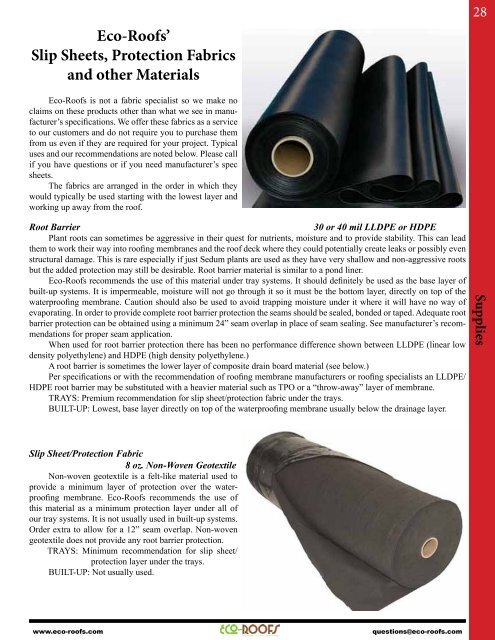Eco-Roofs Brochure and Specifications PDF - Eco-Roofs Green ...
Eco-Roofs Brochure and Specifications PDF - Eco-Roofs Green ...
Eco-Roofs Brochure and Specifications PDF - Eco-Roofs Green ...
You also want an ePaper? Increase the reach of your titles
YUMPU automatically turns print PDFs into web optimized ePapers that Google loves.
<strong>Eco</strong>-<strong>Roofs</strong>’<br />
Slip Sheets, Protection Fabrics<br />
<strong>and</strong> other Materials<br />
<strong>Eco</strong>-<strong>Roofs</strong> is not a fabric specialist so we make no<br />
claims on these products other than what we see in manufacturer’s<br />
specifications. We offer these fabrics as a service<br />
to our customers <strong>and</strong> do not require you to purchase them<br />
from us even if they are required for your project. Typical<br />
uses <strong>and</strong> our recommendations are noted below. Please call<br />
if you have questions or if you need manufacturer’s spec<br />
sheets.<br />
The fabrics are arranged in the order in which they<br />
would typically be used starting with the lowest layer <strong>and</strong><br />
working up away from the roof.<br />
Root Barrier 30 or 40 mil LLDPE or HDPE<br />
Plant roots can sometimes be aggressive in their quest for nutrients, moisture <strong>and</strong> to provide stability. This can lead<br />
them to work their way into roofing membranes <strong>and</strong> the roof deck where they could potentially create leaks or possibly even<br />
structural damage. This is rare especially if just Sedum plants are used as they have very shallow <strong>and</strong> non-aggressive roots<br />
but the added protection may still be desirable. Root barrier material is similar to a pond liner.<br />
<strong>Eco</strong>-<strong>Roofs</strong> recommends the use of this material under tray systems. It should definitely be used as the base layer of<br />
built-up systems. It is impermeable, moisture will not go through it so it must be the bottom layer, directly on top of the<br />
waterproofing membrane. Caution should also be used to avoid trapping moisture under it where it will have no way of<br />
evaporating. In order to provide complete root barrier protection the seams should be sealed, bonded or taped. Adequate root<br />
barrier protection can be obtained using a minimum 24” seam overlap in place of seam sealing. See manufacturer’s recommendations<br />
for proper seam application.<br />
When used for root barrier protection there has been no performance difference shown between LLDPE (linear low<br />
density polyethylene) <strong>and</strong> HDPE (high density polyethylene.)<br />
A root barrier is sometimes the lower layer of composite drain board material (see below.)<br />
Per specifications or with the recommendation of roofing membrane manufacturers or roofing specialists an LLDPE/<br />
HDPE root barrier may be substituted with a heavier material such as TPO or a “throw-away” layer of membrane.<br />
TRAYS: Premium recommendation for slip sheet/protection fabric under the trays.<br />
BUILT-UP: Lowest, base layer directly on top of the waterproofing membrane usually below the drainage layer.<br />
Slip Sheet/Protection Fabric<br />
8 oz. Non-Woven Geotextile<br />
Non-woven geotextile is a felt-like material used to<br />
provide a minimum layer of protection over the waterproofing<br />
membrane. <strong>Eco</strong>-<strong>Roofs</strong> recommends the use of<br />
this material as a minimum protection layer under all of<br />
our tray systems. It is not usually used in built-up systems.<br />
Order extra to allow for a 12” seam overlap. Non-woven<br />
geotextile does not provide any root barrier protection.<br />
TRAYS: Minimum recommendation for slip sheet/<br />
protection layer under the trays.<br />
BUILT-UP: Not usually used.<br />
www.eco-roofs.com<br />
questions@eco-roofs.com<br />
28<br />
Supplies


